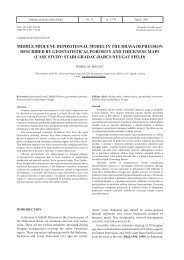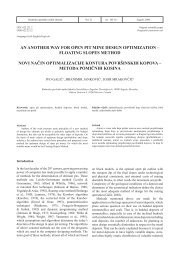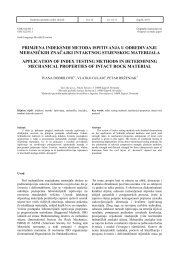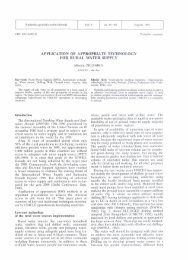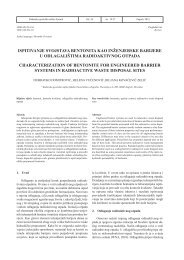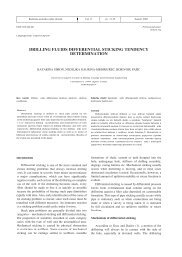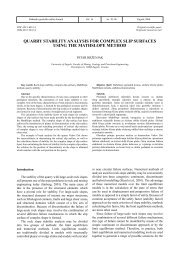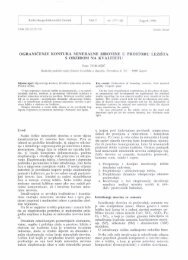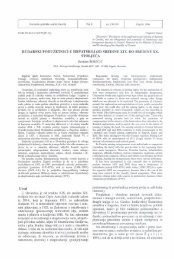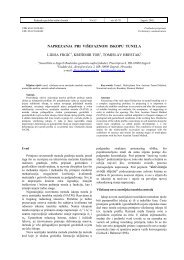continuum and discontinuum modelling in tunnel engineering
continuum and discontinuum modelling in tunnel engineering
continuum and discontinuum modelling in tunnel engineering
You also want an ePaper? Increase the reach of your titles
YUMPU automatically turns print PDFs into web optimized ePapers that Google loves.
Rud.-gco1.-naft. zb., Vol. 12, Zagreb, 2000.52 Rarlu, G., Barla M.: Cont<strong>in</strong>uum <strong>and</strong> dis<strong>cont<strong>in</strong>uum</strong> <strong>modell<strong>in</strong>g</strong>m., r[-I6.1where o~,~ <strong>and</strong> a o,, are the uniaxial compressivestrength values (peak <strong>and</strong> residual) <strong>and</strong> mipp <strong>and</strong> mi,, arethe correspond<strong>in</strong>g Hoek-Brown empirical constants.For very good quality rock masses, which is the casefor a significant <strong>tunnel</strong> length (Figure ll), typical rockmass properties can be def<strong>in</strong>ed on the basis of the GeologicalStrength Index (GSI) as follows:Intact rock strengthoCi = 144 MPaHoek-Brown constant m, =7.0Geological Strength Index GSI = 70Hoek-Brown constant mb =2.4Hoek-Brown constant s =0.02Rock mass compressive strength o,,= 27.2 MPaDeformation modulus E, =35 GPa3.4. In situ stress conditionsIn view of the high overburden <strong>and</strong> closer valley side,associated with evidence of deformation <strong>and</strong> th<strong>in</strong> slabb<strong>in</strong>g<strong>in</strong> isolated sections along the <strong>tunnel</strong> length, it wasrecommended that stress measurements by means of flat-jack tests <strong>and</strong> hydraulic m<strong>in</strong>ifracture tests be carriedout. At present only the flat-jack test data are available Gas follows, derived from measurements around the sec- -r=02 /tion of the <strong>tunnel</strong> at ch 950 m, where the overburden isapproximately 400 m:Figure 16. (a) Mmum pr<strong>in</strong>crpul .!tre.r\ contours. (6) Computed <strong>and</strong>meusured tangential strrsse.s Fht-jack slot tests, wtth overbur-Angle with respect toJack presyureden of 400 m approximatelyFlat-jack slot horizontal axisPI[MPalvalues of oCi <strong>and</strong> s = 1. The stability of the <strong>tunnel</strong> wasMI 0 34.8 assessed by computation of the strength factor contoursas shown <strong>in</strong> Figure 17. The implication is that the rockM2 +50 3.3mass <strong>in</strong>side the unit strength factor contour (SF(m,ol = 1)M3 -45 23.5 will be unstable, unless well reta<strong>in</strong>ed.Based on a stress concentration study <strong>in</strong> l<strong>in</strong>early elas-the above simplifiedtic conditions around the <strong>tunnel</strong> us<strong>in</strong>g the f<strong>in</strong>ite element l<strong>in</strong>early elastic costitutive model, no <strong>in</strong>fluence of hy-method <strong>and</strong> the phase2 code cur ab<strong>and</strong> c ku *, drostatic head considered, etc.) the <strong>tunnel</strong> experi-1997), as shown <strong>in</strong> ~i~~~~ 1 , the <strong>in</strong>itial stresses <strong>in</strong> the ences localized failure at the sidewalls which deepensplane perpendicular to the <strong>tunnel</strong> axis were evaluated to <strong>in</strong>side the rock mass as the micaschist <strong>in</strong>tact rockbe as follows: uniaxial compressive strength decreases from 100MPa to 75 MPa. This would signify that <strong>in</strong> the highlyol = maximum pr<strong>in</strong>cipal stress =13 MPaanisotropic stress regime of the <strong>tunnel</strong>, as evidencedo3 = m<strong>in</strong>imum pr<strong>in</strong>cipal stress = 2.6 MPawith a I?, value equal to 0.2, localized slabb<strong>in</strong>g <strong>in</strong>sta-O1 = angle of ol with respect to the vertical axis =15O bility cannot be ruled out, if the rock strength is <strong>in</strong> therange 100-75 MPa.3.5. Cont<strong>in</strong>uum <strong>modell<strong>in</strong>g</strong>3.5.1. The m = 0 approachIn order to determ<strong>in</strong>e to what extent the adoption ofa <strong>cont<strong>in</strong>uum</strong> <strong>modell<strong>in</strong>g</strong> approach can provide a reasonable<strong>in</strong>terpretation of <strong>tunnel</strong> <strong>in</strong>stability, numerical analyseswere first carried out to assess the stability conditionsby us<strong>in</strong>g a constant deviatoric stress criterion as proposedby (M a r t i n et a 1. (1997).The <strong>in</strong>itial stresses o, <strong>and</strong> 03 at the cross section of<strong>in</strong>terest (ch 2360 m) were assumed to be proportionallyhigher <strong>in</strong> relation to the higher overburden of 650 m.Also, the stress ratio (q,) of the m<strong>in</strong>imum stress tomaximum stress (03/01) <strong>in</strong> the plane of the <strong>tunnel</strong> crosssection was considered equal to 0.2, as <strong>in</strong> the section ofthe flat-jack measurements.The m = 0 analyses were performed by us<strong>in</strong>g thephases2 code <strong>and</strong> the Hoek-Brown criterion for different3.5.2. The elastic-brittle-plastic modelThe analyses above considered overstress<strong>in</strong>g of therockmass around the <strong>tunnel</strong> periphery, without account<strong>in</strong>gfor the presence of discont<strong>in</strong>uities. Therefore, it wasdecided to analyse the same <strong>in</strong>stability problem by <strong>in</strong>troduc<strong>in</strong>gthese features <strong>in</strong> the numerical model.As shown <strong>in</strong> Figure 18, the model comprises twoparallel discont<strong>in</strong>uities near the right sidewall, dipp<strong>in</strong>gtoward the <strong>tunnel</strong>. In order to account for the rock massdisturbance due to jo<strong>in</strong>t<strong>in</strong>g <strong>in</strong> the proximity of the discont<strong>in</strong>uities<strong>and</strong> the apparently more massive rock onthe left sidewall, where relatively little slabb<strong>in</strong>g <strong>and</strong> overstress<strong>in</strong>gwas present, it was decided to <strong>in</strong>troduce threedifferent regions <strong>in</strong> the model with the follow<strong>in</strong>g materialproperties, accord<strong>in</strong>g to the Hoek-Brown failurecriterion:



